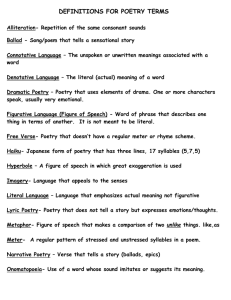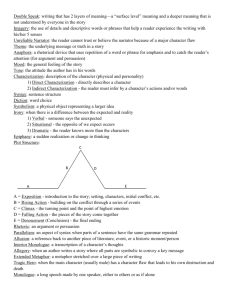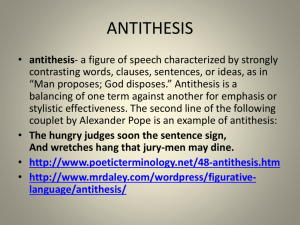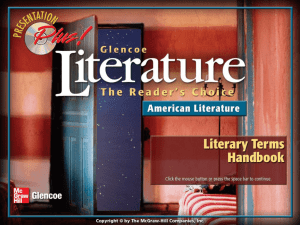Literary_Terms_PowerPoint
advertisement
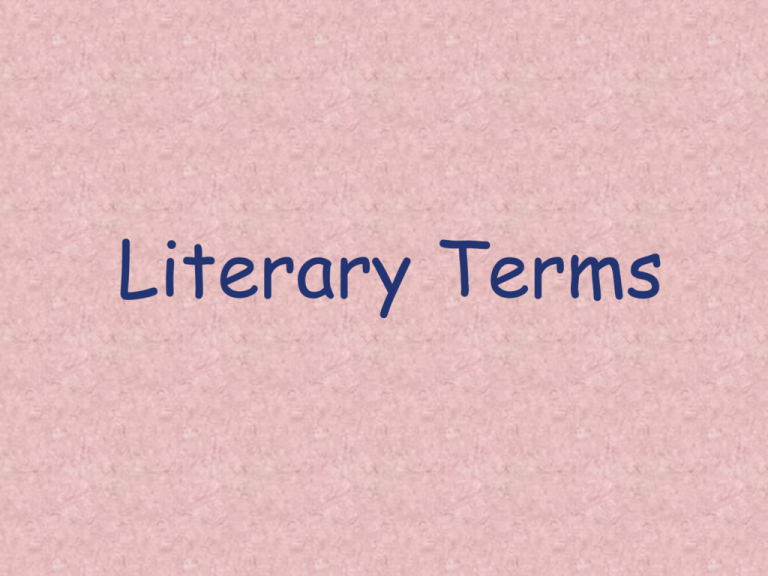
Literary Terms Allegory: A story which has meaning on both the literal and figurative or moral level. e.g. “Young Goodman Brown” Scarlet Letter Star Wars Alliteration: The repetition of sounds in a group of words as in “Peter Piper Picked a Peck of Pickled Peppers.” Allusion: A reference to a person, place, or thing--often literary, mythological, or historical. The infinitive of allusion is to allude. e.g. Romeo alludes to the mythological figure Diana in the balcony scene. Antagonist: A major character who opposes the protagonist in a story or play. Archetype: A character who represents a certain type of person. e.g. mother/father figure hero/heroine the know-it-all Assonance: The repetition of vowel sounds as in “And so, all the night-tide, I lie down by the side Of my darling, my darling, my life and my bride. --Edgar Allan Poe, Annabel Lee Atmosphere: The overall feeling of a work, which is related to tone and mood. Audience: The audience for a piece of literature may be a single person or a group of people. To what person or group is the text directed? Blank verse: Unrhymed lines of poetry usually in iambic pentameter. Plenty of modern poetry is written in blank verse. Characterization: The means by which an author establishes character. An author may directly describe the appearance and personality of character or show it through action or dialogue. Climax: The point at which the action in a story or play reaches its emotional peak. Conflict: The struggle in the story. Traditionally, there are four main conflicts: person vs. self (internal) person vs. person (external) person vs. society (external) person vs. nature (external) Consonance: The repetition of consonant sounds as in “The fair breeze blew, the white foam flew, The furrow followed free;” --The Rime of the Ancient Mariner Contrast: To explain how two things differ. To compare and contrast is to explain how two things are alike and how they are different. Couplets: A pair of rhyming lines in a poem often set off from the rest of the poem. Shakespeare’s sonnets all end in couplets. Denouement: The resolution of the conflict in a plot after the climax. It also refers to the resolution of the action in a story or play after the principal drama is resolved. e.g. Romeo and Juliet’s families decide to build statues after their death. Diction 1)Word choice. 2) The author’s choice of words. An author has the option of choosing any word from our language, why does he/she choose to use certain words and not others? In order to create a certain tone. Denotation 1)The definition of a word found in the dictionary. 2)Literal meaning of a word. 3) The verb form is “to denote” which means “to mean.” e.g. The word “indolence” denotes “laziness.” Connotation 1)The definition of a word found outside of the dictionary. 2)Figurative meaning of a word. 3) The verb form is “to connote” which means “to suggest or imply a meaning beyond the literal meaning of a word.” e.g. The word “cool” connotes “an awesome or exciting thing.” Claim What the writer wants to prove. Also called an assertion, position, or thesis. Counter-claim or Counter-argument An opinion that challenges the reasoning behind a position and shows that there are grounds for having an opposite view. Dramatic Monologue: A poem in which the speaker reveals his or her character through an extended speech or a one-way dialogue. e.g. Browning’s “My Last Duchess” Elegy: A poem mourning the dead. End rhyme: Rhyming words that are at the ends of their respective lines—what we typically think of as normal rhyme. Epic: A long poem narrating the adventures of a heroic figure e.g. Homer’s The Odyssey. Fable: A story that illustrates a moral often using animals as characters e.g. The Tortoise and the Hare Figurative Language: Whenever you describe something by comparing it with something else, you are using figurative language. Any language that goes beyond the literal meaning of words in order to furnish new effects or fresh insights into an idea or a subject. e.g. Whenever you call something “cool,” you’re not talking about its temperature but referring to some other quality it possesses. Foreshadowing: A technique in which an author gives clues about something that will happen later in the story. Free Verse: Poetry with no set meter (rhythm) or rhyme scheme. Genre: A term used to describe a particular category or type of literature. Some literary genres are mysteries, westerns, and romances. Hyperbole: An extreme exaggeration. e.g. To say that it took you hours to walk home when in reality it was only 10 mins would be a hyperbole. Iambic pentameter: Ten-syllable lines in which every other syllable is stressed. -’ e.g. “With eyes like stars upon the brave night air.” Imagery: The use of description that helps the reader imagine how something looks, sounds, feels, smells, or tastes. Most of the time, it refers to appearance. e.g. “Tita was so sensitive to onions, any time they were being chopped, they say she would just cry and cry; when she was still in my great-grandmother’s belly her sobs were so loud that even Nacha, the cook, who was half-deaf, could hear them easily.” --Like Water for Chocolate Internal rhyme: A rhyme that occurs within one line such as “He’s King of the Swing.” Irony: Language that conveys a certain idea by saying just the opposite. e.g. Saying that you love someone’s shirt when you really think it’s ugly is being ironic. Literal Language: Language that means exactly what it says. Lyric: A type of poetry that expresses the poet’s emotions. It often tells some sort of brief story, engaging the reader in the experience. Logos: An appeal to the audience’s logic—common sense—in rhetoric. Ethos: An appeal to the audience’s ethics—knowing right from wrong—in rhetoric. Pathos: An appeal to the audience’s emotions in rhetoric. Metaphor: A comparison of two unlike things using any form of the verb “to be”–-i.e. am, are, is, was, were. Ex: “This chair is a rock,” or “I am an island.” Meter: The pattern of stressed and unstressed syllables in the lines of a poem. Monologue: A long speech by one character in a play or story. Mood: The feeling created in the reader by a literary work or passage. The mood may be suggested by the writer's choice of words, by events in the work, or by the physical setting. Motif: A recurrent image, word, phrase, or action that tends to unify the literary work or that forms the theme in a work of literature. Myth: A legend that embodies the beliefs of people and offers some explanation for natural and social phenomena. Onomatopoeia: The use of words that sound like what they mean such as “buzz,” “bang,” or “tic-tock.” Paradox: a statement that is apparently self-contradictory or absurd but really contains a possible truth. e.g. Cowards die many times before their deaths. --Shakespeare’s Julius Caesar Parallelism: The use of similar grammatical structure for effect. e.g. I came, I saw, I conquered. Also, a requirement in grammar to use the same grammatical form for cojoined ideas. e.g. We went biking, sailing, and hiking on our trip, not We went biking, sailing, and hiked on our trip. Parody: A humorous, exaggerated imitation of a work of literature. Personification: Giving inanimate objects human characteristics. e.g. “The wind howled through the night.” Plot: The series of events that form the story. Point of View (P.O.V): The perspective from which the story is told. Narrators of stories can take on three points of view: 1st person= “I/we” 2nd person= “you” 3rd person= “he/she, they/them” Omniscient Point of view The narrator is an all-knowing outsider who can enter the minds of all of the characters. Prose: Writing organized into sentences and paragraphs that is not poetry. e.g. Novels and short stories are examples of prose. Protagonist: The main character of a novel, play, or story. Pun: The use of a word in a way that plays on its different meanings. e.g. “Noticing the bunch of bananas, the hungry gorilla went ape.” Quatrain: A four-line stanza. Rhetorical Question: A question not meant to be answered but asked solely to produce an effect or to make a statement. The purpose to such a question, whose answer is obvious, is usually to make a deeper impression upon the hearer or reader than a direct statement would. Its effect is to make the reader stop and think about what is being asked. e.g. “How many times have I asked you to take out the trash?” Sarcasm: Language that conveys a certain idea by saying just the opposite such as if it’s raining outside and you say, “My, what a beautiful day.” Satire: A work that makes fun of something or someone. e.g. Swift’s “A Modest Proposal” The Simpsons South Park Simile: Comparing two unlike things using “like” or “as.” e.g. “I’m as hungry as a pig,” or “Your eyes are like stars that brighten my night.” Soliloquy: A monologue in which a character expresses his or her thoughts to the audience and does not intend the other characters to hear them. Sonnet: A fourteen-line poem written in iambic pentameter. Different kinds of sonnets have different rhyme schemes. The most notable are Shakespeare’s Sonnets which employ the abab,cdcd,efef,gg rhyme scheme. Stanza: A major subdivision in a poem. A stanza of two lines is called a couplet; a stanza of three lines is called a tercet; a stanza of four lines is called a quatrain. Subplot: The secondary action of a story, complete and interesting in its own right, that reinforces or contrasts with the main plot. There may be more than one subplot, and sometimes as many as three, four, or even more, running through a piece of fiction. Subplots are generally either analogous to the main plot, thereby enhancing our understanding of it, or extraneous to the main plot, to provide relief from it. Symbolism: The use of one thing to represent another. Something that stands for something else. e.g. A dove is a symbol of peace. Theme: The central idea of a work. Tone: The author’s attitude toward the subject of the work. Usually positive or negative. e.g. The tone of a piece of literature could be pessimistic, optimistic, angry, or sarcastic. Voice: The authorial presence in a piece of literature whether in the first, second, or third person.




